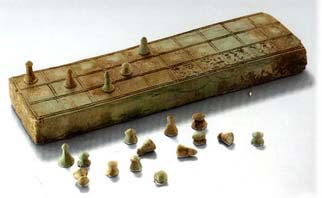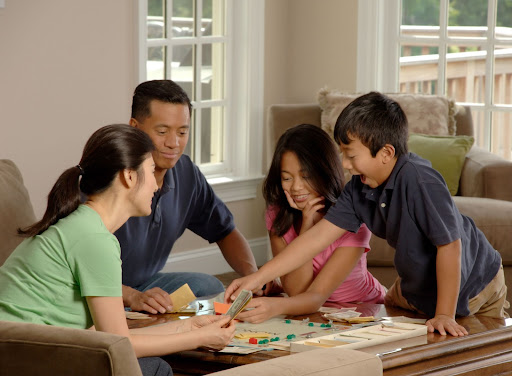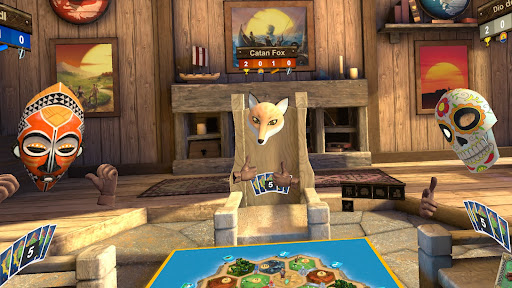#1 Origins of the board game
It would seem that the first “board game” (known) comes from Egypt and dates from 3000 years before Christ. This game consisted of moving pawns in three rows of ten squares. Representations, on the tombs of pharaohs, show that a game, the Senet (passage game played by two, considered the ancestor of Backgammon), existed, still in Egypt, around -2650 years BC. Other games emerged until the games we know today: Chatrang (Persia) around the 600th century AD or Chaturanga (Indian) in the XNUMXs.
The game of Senet, a checkerboard shape of 30 squares divided into 3 rows.
#2 Board Game Definition
Playing board games is a complex social experience characterized by two levels of interaction: the interaction between the players themselves (generating for example discussions around strategies), but also the interaction mediated by physical artifacts representing information and initiating actions (e.g. rolling a dice, drawing a card, advancing on a board, etc.).
Johan Huizinga, in 1938, defined play as "a voluntary action or activity, accomplished within certain fixed limits of time and place, following a rule freely consented to, but completely imperious, provided with an end in itself, accompanied by a feeling of tension and joy, and an awareness of being other than in everyday life”. And the player cuts himself off from his reality when he participates in a game, he is immersed in the playful experience; which could explain the long games of Monopoly I was able to play with my family and friends.
We can conclude that the board game is an immersive medium. Once that is said, how can we not think of the user experience lived in a board game situation?
As I said, my intervention was “a very long time ago” and since then, my practice has evolved a little and my interventions have touched on other areas, just as interesting, but very distant.
I then plunged back into the subject but, above all, I contacted Emmanuelle Marevery (Science Consumer Maganer/UX @Amodée) and Tom Fromantin (Market & UX Researcher @Asmodée) to (better than me) talk to us about UX in board game design.
Although I have given some "scientific" definitions of the board game, I wanted to know their definition (without giving them time to think and without going to see the definitions that are made today 😉 ).
For Emmanuelle, board games are fun, self-help activities that allow you to spend quality time with friends and relatives.
For uneducated people like me, here is a definition of autotelic: which is undertaken for no other purpose than itself, speaking of an activity.
For Tom, it is difficult to give a single definition given the variety of types of board games that exist and he preferred to give us the purpose of this type of game. According to him, they allow to create a link, to better discover others and oneself by using various abilities or personal skills (reasoning, logic, general culture, humor, social ease, etc.) depending on the type of game you are playing.
#3 User research in the field of board games
More specifically, they intervene upstream and downstream of Game Design; a little less during Game Design “because the designers are autonomous”.
Upstream of Game Design, user research can focus on the study of leisure trends such as board games, player expectations or even on ways to improve an existing version of a game several years before. the release of a new version.
They can intervene on aspects of Game Design, where they will check if the users easily understand the game mechanics, and if the complexity is not repulsive; or on ergonomic aspects, where they may be required, for example, to check whether the rulebook of a game is read and learned easily by the players.
On the method side, they carry out user research by conducting studies to collect quantitative and/or qualitative data, with a hint of biometrics and data science.
The data collected most often comes from questionnaires, interviews or text mining.
Emmanuelle also explained to me that they develop their own methods. For example, they have developed an expert audit grid to validate board game manuals or they capitalized on guidelines drawn from learning from user tests.
In the context of board games, by using these so-called UX methodologies and collaborating with a data analyst, they can complement the expertise of game designers with notions of psychology and ergonomics via user feedback. This allows them to verify throughout the design (and even after the game is released) that the game experience intended by the creative studio is the best possible for the users.
This involves workshops for the design of the Brand Bible (visual elements and consistency) of their games, the clarification of creative intentions, the description of the game or even the production of logos, colorama (color chart of the brand ), pattern (graphic pattern) or packaging before testing them with users.
To carry out their missions, they adopt a systemic vision of their games by realizing brand tracker type studies, text mining on reviews, mock up tests, co-design on board games on Nintendo, game unboxing tests.
For the moment, Emmanuelle has observed more than 1000 people during their games, solicited nearly 25 people for her tests and studies and studied millions of opinions!
“Thank you text mining!” Emmanuelle Marevery
As I said, 9 years ago, Asmodée was already concerned about the gaming experience of their customers/users. Emmanuelle told me that all the teams in the group are interested in user knowledge; and it's nice to hear. Requests can come from creative studios, marketing or strategic teams.
#4 “Digitalization” and “digitization” of board games
And in 9 years, methods in user research and ergonomics for board games have evolved, as have their uses. Three types of new uses come to mind: online board games, board games with Augmented Reality and board games in Virtual Reality.
Quickly, regarding the pros and cons of each :
For online board games, they are easily played from anywhere and with anyone. You're going on vacation and you can't bring your board games; a smartphone and an internet connection can allow you to play many board games. And you can play it with your friends who are with you as well as remotely with friends or strangers.
For board games with Augmented Reality or Virtual Reality, the principle is not the same because you will need Augmented Reality glasses or a Virtual Reality headset. The cost of these devices is therefore not negligible and further limits the number of players equipped. In addition, still quite a few games are available in this format. However, for those who exist, the immersion is total. If you play Werewolves of Thiercelieux for example, you will have the chance to sit in the village of the game, among the other villagers. You will also see werewolves appear as they are unmasked. Enough to add a lot of appeal to the most classic board games.
And, as a board game player, for these three game formats, when played remotely, with strangers, I find that the games do not have the same flavor as the games with family or friends. . But as a UX Researcher, this is a topic that makes you want to. I asked Emmanuelle and Tom what they thought of it and Emmanuelle is “excited by all that we can do and the margin for innovation”. She points out that these types of formats have been around for a long time but that the solutions offered are sometimes immature and that the audience is not quite ready for them yet; that some purists play board games to detox from digital. Tom, he finds the contribution of these formats very interesting because they bring a diversity in the way of playing; they allow you to rediscover the games you know from another angle.
#5 Hijacking board games
To finish this article on board games, I wanted to address the notion of misappropriation of board games.
Today, many fields use board games and divert their design uses. For example, board games are used by some teachers for learning a foreign language or by some caregivers with patients. In the field of UX, we also have our little tricksters who divert them to carry out workshops.
Of course, Emmanuelle, who works in the field of UX and board games, has made it a specialty and even led, with Carole Laimay, a workshop on this subject. during UX Camp 2019.
Here are some examples of workshops where board games can be used :
- The ice breaker :
The purpose of the ice breaker is to break the ice before a meeting or a workshop. With the pick-it, you can place several cards on a table, on each card is drawn an object. Each participant must then choose a card that represents them and explain why. These games allow participants to get to know each other in a fun way.
- Ideation :
The objective of ideation workshops is to stimulate everyone's creativity in order to bring out innovative ideas. Here are two board games that we can use for this type of workshop: “cards against humanity” which consists of filling in blank sentences and voting for the best proposal; and the Dixit game which allowse stimulate his imagination with his inspiring cards.
Some cards from the Dixit game
- Idea selection or voting :
After an ideation session, for example, comes the time to vote on ideas. this step is often done with stickers but it can also be done with UNO cards by prioritizing ideas with the value of the cards or even with Monopoly (or La Bonne Paie 😉) banknotes by giving a budget so that the participants “buy” the ideas.
#6 Closing
From 3000 BC to today, board games have evolved somewhat, but above all, they have been marketed and represent a sufficiently large turnover for us to care about the players' gaming experience. and therefore that we do user research.
The areas where user research methodologies can be mobilized are as varied as the areas where there are users (both B2C, B2B, B2B2C, B2E). After the autonomous vehicle and board games, I can't wait to show you another “amazing” field in which I have intervened. What area do you think will be covered?
Celine POISSON, Lead UX Research @UX-Republic – Doctor in Ergonomics
Our next trainings
UX/UI ECO-DESIGN # Paris
SMILE Paris
163 quay of Doctor Dervaux 92600 Asnières-sur-Seine
DESIGN THINKING: CREATING INNOVATION # Belgium
UX-REPUBLIC Belgium
12 avenue de Broqueville - 1150 Woluwe-Saint-Pierre
MANAGING AND MEASURING UX # Paris
SMILE Paris
163 quay of Doctor Dervaux 92600 Asnières-sur-Seine
DESIGN SPRINT: INITIATION & FACILITATION # Paris
SMILE Paris
163 quay of Doctor Dervaux 92600 Asnières-sur-Seine
UX-DESIGN: THE FUNDAMENTALS # Belgium
UX-REPUBLIC Belgium
12 avenue de Broqueville - 1150 Woluwe-Saint-Pierre
GOOGLE ANALYTICS 4 #Paris
SMILE Paris
163 quay of Doctor Dervaux 92600 Asnières-sur-Seine
ACCESSIBLE UX/UI DESIGN # Belgium
UX-REPUBLIC Belgium
12 avenue de Broqueville - 1150 Woluwe-Saint-Pierre
EXPERIENCE MAPPING # Paris
SMILE Paris
163 quay of Doctor Dervaux 92600 Asnières-sur-Seine
















